The best thing about using a soaker hose is that it saves you some money. This Buzzle article will give you useful tips on how to install and use a soaker hose, along with information about the fittings that you will need for the job.
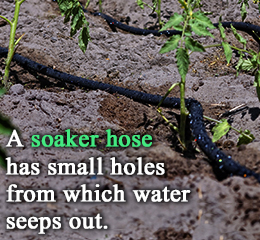 A soaker hose should not be used on lawns. This is because, roots may penetrate the hose, clogging it.
A soaker hose should not be used on lawns. This is because, roots may penetrate the hose, clogging it.The most traditional methods for watering gardens have been overhead sprinklers or by hand-held garden hoses. Needless to say, these methods have their own share of annoying drawbacks. It is very easy to over-water plants, leading to waterlogged soil with puddles. A significant amount of water is also wasted by evaporation. One might not have the patience to use a hand-held hose everyday. The invention of the soaker hose has changed it all.
Soaker hoses are a form of drip water irrigation systems in which it is possible to discharge water directly near the roots, leading to less wastage of water. This is a highly affordable and durable method of watering a garden, since soaker hoses are UV-resistant, meaning that they will not degrade because of exposure to sunlight, and also will not suffer from freezing problems in the winters. Moreover, the plants will not develop any fungal disease because this system will not wet the plant leaves.
A soaker hose is a rubber tube with hundreds of holes all over its circumference, such that, when it is connected to a source of water, water seeps through these holes at a steady rate into the soil. It is also possible to automate the process by connecting a timer to the faucet, to turn the water supply on and off as needed, without venturing out into the garden. Costing, on average, between $15 to $40, installing a soaker hose is a relatively cheap process, and is also a perfect do-it-yourself task. The complete step-by-step instructions for installing and using a soaker hose are given below, along with several important tips that you need to keep in mind.
Fittings for a Soaker Hose
- Garden hose
- Soaker hose
- Hose pins
- Faucet adapter
- Programmable timer
- Pressure reducer
- Tee connectors
- Backflow valve
Tools Needed
✔ Measuring tape
✔ Mulch
✔ Trowel
Tips to Install a Soaker Hose
Using a measuring tape, first take accurate measurements of your garden to determine the length of the hose that you will need.
Take a soaker hose of adequate length and arrange it in your garden around the base of the plants. If the plants are along a straight line, lay the hose out straight along the space between them. If the plants in your garden are randomly arranged, then lay out the hose in round turns around the base of each plant. Fix it in position using hose pins.
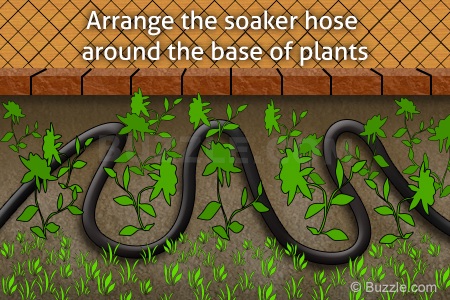
Connect a pressure reducer to your garden faucet. Then, using a faucet adapter, connect an ordinary garden hose to the faucet.
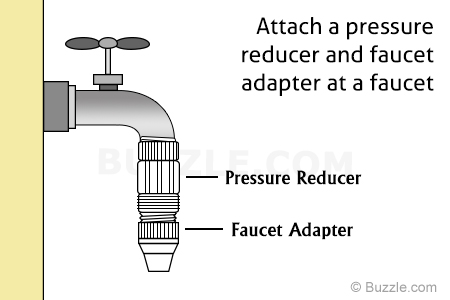
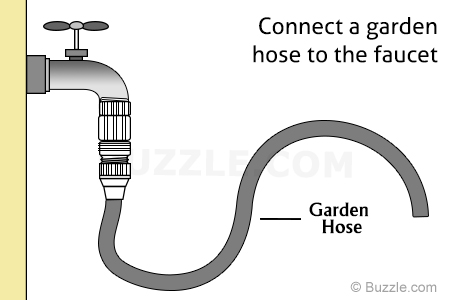
Attach the other end of the garden hose to one end of your soaker hose, using a hose connector. If your garden is small, you can even directly connect the soaker hose to the faucet.
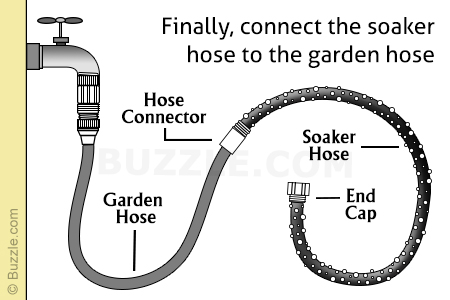
To reach distant areas of the garden, you can connect another soaker hose to the one already connected. Connect all the sections using hose connectors. Do not plug the end of the last soaker hose with an end cap just yet.
Turn on the faucet for a couple of minutes to flush water out through the entire system.
After this, fix the end cap at the open end of the last soaker hose. Turn on the water flow again at a reduced pressure. Observe the hose for any leaks from the fittings between the pipes. Allow the water to seep out to a depth of 6 to 12 inches in the soil. Then, turn off the faucet and wait for some more time to let the water get completely absorbed in the soil.
Using a trowel, gently dig around the plant roots to see if the water has reached them. Using this technique, determine how much time is needed for the water to reach the roots once you turn on the faucet. You can then connect a programmable timer to the faucet so that the water supply gets switched off after the desired time duration every day.
If you see any dry spots in the garden after the first watering, change the layout of the soaker hose accordingly. Then, dig a 4" trench in the soil and bury the hose in. This ensures that water is directly released to the root sections of the plants, and also prevents trampling of the hose.
Tips:
☞ Check your local area code to see if you need to add a backflow valve between the soaker and the garden hose. This prevents contaminated water from entering the drinking water supply.
☞ When laying the hose, lay it across a slope, and not up or down a slope.
☞ If you don't have a pressure reducer, you can manage by partly turning on the faucet, rather than completely.
☞ The different lengths of soaker hoses should be separated by 18 inches in sandy soils and by 24 inches in clay soils for perennial plants.
☞ For annual plants, the runs of the soaker hose should be 12 - 18" apart from their base, as they have shallow roots.
☞ When laying one around a tree, the turns should not be closer than 3" from the base, and not farther than the drip line.
☞ Burying the hose with two inches of mulch helps evenly distribute the water, besides reducing water loss through evaporation.
☞ If you want to lay out parallel lengths to water different zones of the garden, connect them using tee connectors.
☞ The length of the hose used must not exceed 100 feet, because the water pressure is low at such distances.
☞ You can install a calcium filter in the system to prevent clogging by soil minerals.
☞ Very high water pressure can damage the hose in the long run. Always adjust the water pressure between 25 to 50 psi, with 25 psi being the most recommended value.
How to Use a Soaker Hose
To use the soaker hose, all you have to do is turn on the faucet. If a programmable timer is installed, then it will automatically turn on and even turn off the water supply at the scheduled time.
Turn on the hose daily, either in the morning or evening. Water the garden till the moisture properly penetrates the soil, but avoid making it soggy.
You can switch to watering on alternate days, if the plants appear well hydrated.
The recommended approach is to water infrequently but deeply, to ensure that the plants grow a deep root system.
Tips:
☞ Flush your soaker hose at least once a year by removing the end cap and turning on the faucet.
☞ Remember the position of the hose if you regularly till the garden, to avoid damaging it. Or else, bury the hose at a depth of 6 - 8", though it's best if it is covered with mulch rather than being buried.
☞ To prolong the life of the hose, remove and keep it inside the house during the winter.
☞ In general, a soaker hose should not be used to water plants or trees that are fart apart, because the area between them will unnecessarily get watered.
While it's extremely easy to install and use a soaker hose, the fact that it is made from recycled rubber makes it undesirable for use on food crops. Also, it cannot be used to 'target' a water spray towards a certain plant, like traditional watering systems.






 A soaker hose should not be used on lawns. This is because, roots may penetrate the hose, clogging it.The most traditional methods for watering gardens have been overhead sprinklers or by hand-held garden hoses. Needless to say, these methods have their own share of annoying drawbacks. It is very easy to over-water plants, leading to waterlogged soil with puddles. A significant amount of water is also wasted by evaporation. One might not have the patience to use a hand-held hose everyday. The invention of the soaker hose has changed it all.
A soaker hose should not be used on lawns. This is because, roots may penetrate the hose, clogging it.The most traditional methods for watering gardens have been overhead sprinklers or by hand-held garden hoses. Needless to say, these methods have their own share of annoying drawbacks. It is very easy to over-water plants, leading to waterlogged soil with puddles. A significant amount of water is also wasted by evaporation. One might not have the patience to use a hand-held hose everyday. The invention of the soaker hose has changed it all.


